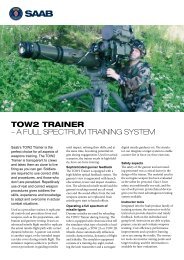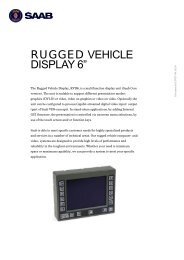Battlefield Command Support System product sheet - Saab
Battlefield Command Support System product sheet - Saab
Battlefield Command Support System product sheet - Saab
You also want an ePaper? Increase the reach of your titles
YUMPU automatically turns print PDFs into web optimized ePapers that Google loves.
WHAT<br />
THROUGH<br />
BY<br />
SITUATIONAL AWARENESS<br />
MESSAGING & DECISION SUPPORT<br />
COMMON TACTICAL PICTURE<br />
command & support<br />
on the ground<br />
The ability to obtain, analyse and<br />
distribute information around the<br />
battlespace is critical to the success of<br />
military operations in the 21 st century.<br />
Efficient management of information is<br />
a force multiplier that enables military<br />
commanders to more effectively employ<br />
the assets under their command. It allows<br />
the Army <strong>Command</strong>er to get inside the<br />
opponents decision loop, providing a<br />
tactical advantage over conventional<br />
command mechanisms.<br />
The <strong>Battlefield</strong> <strong>Command</strong> <strong>Support</strong> <strong>System</strong><br />
is a PC based, fully field deployable,<br />
scalable system developed for the<br />
Australian Army. Empowering the Army<br />
commander by creating the common<br />
tactical picture in a Microsoft Windows<br />
environment.<br />
<strong>System</strong> Capabilities<br />
Deployed from Division Headquarters to<br />
Company level, the <strong>Battlefield</strong> <strong>Command</strong><br />
<strong>Support</strong> <strong>System</strong> is used routinely by Australian<br />
forces during exercises and overseas<br />
deployments. BCSS has been engineered to<br />
provide tactical messaging through legacy,<br />
restricted bandwidth Combat Net Radio<br />
networks while also being able to take full<br />
advantage of higher bandwidth Local Area<br />
Networks, Wireless Data Networks, Wide<br />
Area Networks and satellite links. BCSS provides<br />
a highly mobile tactical and operational<br />
command support system in an integrated<br />
information management, transmission and<br />
dissemination environment.<br />
Architecture<br />
BCSS is hosted on the <strong>Saab</strong> Information<br />
Framework (SIF) which provides a robust,<br />
multi-layered data structure that publishes,<br />
shares and routes information. It is an open<br />
and flexible architecture which supports the<br />
integration of additional applications and<br />
adaptors, including COTS and third party<br />
systems. The SIF is hosted on the industry<br />
standard Microsoft Windows XP operating<br />
system, providing security, a high degree<br />
of user familiarity and supports common<br />
programming languages to enable rapid,<br />
evolutionary development to specific user<br />
requirements.<br />
BCSS provides a flexible information flow<br />
with integrated functionality throughout all<br />
stages of an operation. Near real time CTP<br />
overlays combined with operational status<br />
updates feeding the mission and logistics<br />
planning cycle gives commanders an unprecedented<br />
level of battlefield awareness.<br />
BCSS uses worldwide standards and formats<br />
to facilitate interoperability and enable the<br />
rapid integration of new requirements or<br />
legacy systems. These standards include MIL-<br />
STD-2525B and NATO APP6A symbology<br />
and SQL compliance
key system features<br />
• PC Windowns based C2 & CSS<br />
system<br />
• Communications bearer<br />
independence<br />
• Collaborative mission planning<br />
• Operationally proven<br />
Features of BCSS<br />
• Enhanced Situational Awareness through<br />
common GIS interface.<br />
• Automatic Blue Force tracking through GPS<br />
based positioning.<br />
• Vector and raster moving map display supporting<br />
multiple formats and projections.<br />
• Track and overlay display and creation.<br />
• Route and formation tools.<br />
• Military symbology and drawing tools<br />
• Georeferenced Data display on the tactical<br />
picture<br />
• 2D and 3D Terrain Analysis functions including<br />
Going Analysis, line of sight tool for intervisibility<br />
calculations and radio path profiling and<br />
propagation planning.<br />
• Military Messaging including USMTF, ASMTF<br />
and VMF Message formats over a variety of in<br />
service high and low capacity links.<br />
• Automatic parsing and display of tactical<br />
information in military messages<br />
• ORBAT management tools<br />
• Operational Planning tools for the generation<br />
of plans, orders and briefing materials,<br />
customisable to the end user’s doctrine,<br />
• Logistic <strong>Support</strong> and Capability Status tools<br />
to calculate logistics requirements and record<br />
and highlight the status of all units under<br />
command.<br />
• Engineering tools to support calculation of<br />
mobility, offensive and defensive works.<br />
• Intelligence databases and tools for analysis,<br />
recording and reporting.<br />
• Interoperability with other Combat Management<br />
<strong>System</strong>s such as the ANZAC CMS.<br />
Future systems<br />
At <strong>Saab</strong>, we have our minds set on supporting<br />
our customers in the development of net<br />
centric capabilities. Based on open modular<br />
technology, many of <strong>Saab</strong>’s solutions are<br />
already prepared for the modern network<br />
environment.<br />
By bringing the pieces together we can provide<br />
the advantage of being one step ahead<br />
when every second counts.<br />
The modern battlefield includes a large array<br />
of computerised systems working to assist<br />
land force commanders with fast and efficient<br />
situation awareness, decision support and<br />
weapons and sensor guidance.<br />
Numerous systems interface with the battlefield<br />
systems to provide intelligence, situation<br />
awareness, command information, logistics<br />
and coordinating data. These involve terrestrial<br />
radios, unmanned aerial and ground<br />
based vehicles and satellite based communications<br />
facilities.<br />
The complexity of these growing systems and<br />
the need for precision, clarity and timeliness<br />
is vital for unambiguous command of operations.<br />
<strong>Saab</strong> has long been the system integrator<br />
of choice for the Australian Army and as a<br />
result, has the skills and experience necessary<br />
for meeting these high demands.<br />
Bringing network technology to the battleground<br />
provides forces with a powerful<br />
tool to improve operational effectiveness by<br />
connecting all resources closer together and<br />
making them available for every one within<br />
the network. Nodes in the network now<br />
include formations, vehicles and individual<br />
soldiers, each with varying data and presentational<br />
demands.<br />
The ability to survive in real battle requires<br />
being prepared with live, high quality training<br />
with the possibility to combine other live,<br />
virtual and constructive domains.<br />
Specifications subject to change without notice<br />
www.saabgroup.com<br />
Document id: AU 08-BCSS07


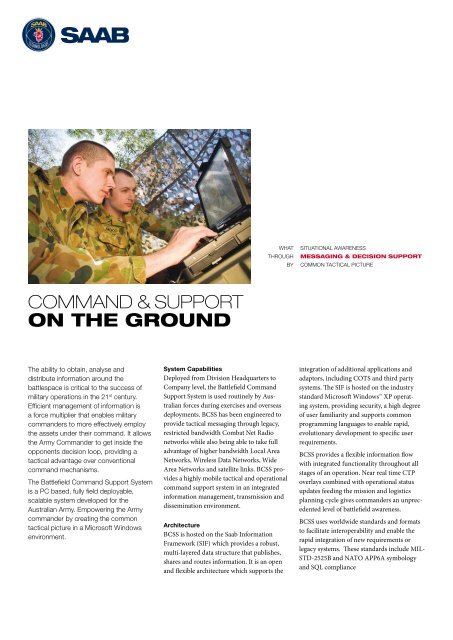

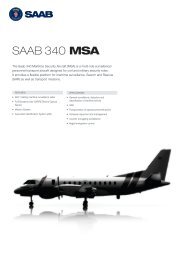
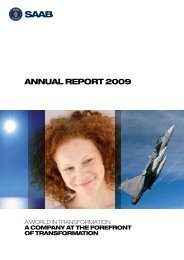
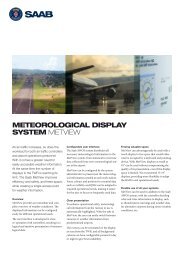
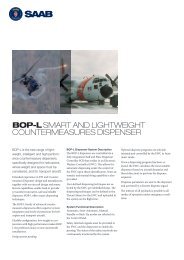


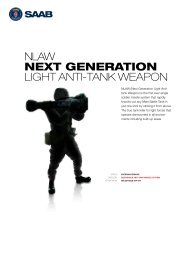
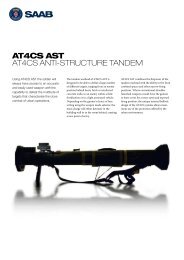

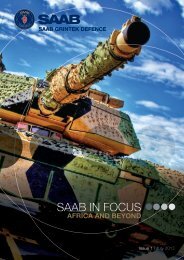
![Proposal long-term incentive programs [pdf] - Saab](https://img.yumpu.com/50411723/1/190x245/proposal-long-term-incentive-programs-pdf-saab.jpg?quality=85)

